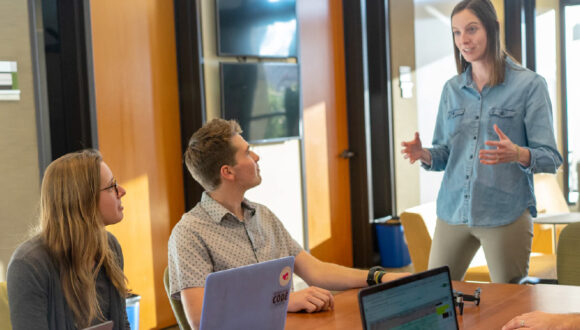I love Highspot—but, of course, I’m biased. So one of my favorite things to do is get out in the field and chat with customers about how much they love Highspot, too. While I was at SiriusDecisions Summit, I had the chance to check in with Joe Andrews, Vice President of Marketing at InsideView, on the current sales enablement efforts there with Highspot.
Here’s the video interview, as well as the interview transcript, below:
Interview Transcript:
Shawnna: Hi, Joe! I’d love to have you provide insights into why you see the sales enablement trend and momentum continuing in the market.
Joe: I see a lot of momentum in sales enablement around only one purpose, which is helping make sales reps more effective. Companies have different definitions, but at InsideView, we look at how we make reps achieve quota at a higher rate and how we make them more efficient in terms of their time. Sales reps spend a lot of time researching information about accounts they’re selling to; how can we put information at their fingertips? How can we make it easier for them to solve a task? And most importantly, how can we give them more time to sell? We look at how we can we help them improve win rates and also achieve their quota.
Shawnna: Why is sales enablement an important investment for companies today?
Joe: Sales enablement is an area of increasing investment for companies — SiriusDecisions has some great data on that. Companies are looking at how best-in-class companies have bridged the gap between marketing and sales. It used to be that marketing teams pushed a lot of content to sales — “threw it over the fence,” so to speak. Sales would have to catch that and then they would have to train. But companies are starting to take a more holistic view that encompasses processes, people, and technology including sales enablement platforms like Highspot, which are helping companies become more efficient and effective at enabling their sales reps.
Shawnna: What are your top sales enablement initiatives?
Joe: InsideView is really focused on increasing customer retention. We measure that with two metrics: renewal rate and upsell rate. As InsideView is bringing new products to market, being effective at selling those to your existing customer base becomes a priority. From a sales enablement perspective, we’re very much focused on helping our reps serve those existing customers and improve their upsell rate to those existing customers.
We’re also equally, if not more importantly, focused on customer success to serve the customers that we have and to continue to make them happy with InsideView and ensure that they’re customers for a long time to come.
Shawnna: How does your team measure sales enablement success?
Joe: Great question! When we started down the path of sales enablement, we were looking at activity-based metrics such as content consumption — the use of specific content pieces when sales outreach was done at various stages. Another example is sales development through a new logo account to renewal through upsell. But now that we are two years into our Highspot engagement, we look at results metrics such as win rate and quota attainment. We believe that any sales enablement initiative needs to show results in terms of both sales performance and the tangible business results.
Shawnna: What did your sales process look like before implementing a sales enablement solution?
Joe: Our sales process has evolved over the last few years. We’ve evolved in terms of the market segments that we go after. We now have a direct and indirect business. On our direct side, we’ve changed how we tiers accounts, how we segment by size, and also changed back to that retention focus. We’ve also taken dedicated focus with account management roles that are really focused on driving expansion with customers. And that complements our CSM role, which focuses on keeping customers happy and making sure that they are successful in adopting our product.
Shawnna: Do you take an account-based approach to sales enablement?
Joe: We take an account-based approach at InsideView. It’s been an evolution, as well, over the last few years. InsideView started by looking at the top-name accounts that sales wanted—and it was definitely a process of identifying and agreeing on those accounts at the start. Now we are taking a more scientific approach using our own tools, where we look at which accounts have the best potential. Then, we refresh that once a year to look at the accounts we’re having success with and how they map to our ideal customer profile (ICP). We also take into consideration what we are hearing from the field—what’s changed in some of these accounts, and how we can engage them better. Then, we adjust our marketing tactics to better the overall experience.
Shawnna: What are the top ways that sales enablement has helped you?
Joe: Sales enablement is responsible for several areas. One of them is training, and we did a survey with our field to understand what topics they needed in terms of training. The other area was around content delivery. Both of these are where Highspot has really come in. We’ve helped our reps become more effective at using their content, and the data shows that there’s a strong correlation between good use of content and quota attainment. Those have both been key areas for sales enablement.
The third area for sales enablement at InsideView has been around a deal desk and focusing on how the entire go-to-market team can help our sales team win key deals. Those three areas of sales enablement are the current focus for InsideView.
Shawnna: Why is sales enablement critical for marketers?
Joe: Any marketing person today should spend time in a sales role or get very close with sales reps. You know that old saying about walking a mile in someone’s shoes. It really helps to understand the challenges that they’re facing. Marketing, as a function, needs to help improve sales. Sales enablement is a bridge between marketing and sales. There are a lot of shared priorities that we’re focused on in terms of content development, training, and supporting key deals. More marketing efforts, like messaging and go-to-market launches, need to be done in collaboration with sales. Sales enablement is key to that.
Shawnna: What advice would you give to those breaking into to sales enablement?
Joe: If you’re brand new to sales enablement, the first thing you should do is get informed. You can do that in a couple of ways: talk with the sales reps, go on customer calls, and observe key challenges. With that intel, you can start to develop an opinion around how you can help as a sales or marketing leader. The other thing you can do is look at the data in terms of your sales process and everything from the marketing funnel down through the sales stages of execution. There are a lot of benchmarks out there. Talk with analysts at SiriusDecisions, Forester, etc. Talk with other companies, benchmark with similar companies in your industry, and get a sense of how are they performing on key metrics. What are some of the challenges that they went through? What are some of the solutions that they would recommend? Be a sponge when you are new in the role, and learn. You’ll form opinions on your own, but you’ll also get a lot of good guidance to help you spring ahead and not have to reinvent the wheel.
For more insight into how InsideView successfully implemented and continues to optimize their sales enablement efforts with Highspot, check out the full case study.



